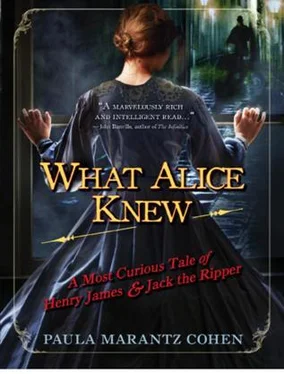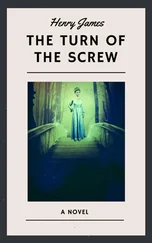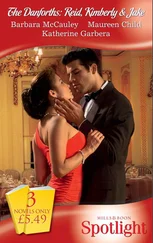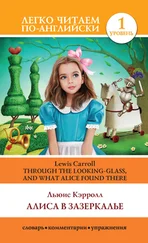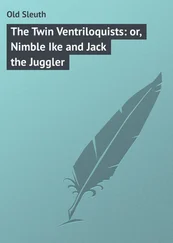He led William through a small recess to another room, where bodies that needed to be specially photographed for purposes of record keeping were displayed before being removed for burial. This room was even more oppressive than the outer area, the sense of claustrophobic enclosure added to the foul odor of rotting corpse. As William entered, he noted that a curtain had been hung in the corner. Abberline walked over to it and then motioned to a chair in front for William to be seated.
“Best to get off your feet for this,” he noted. “It’s not a pretty sight, and I’ve found that viewers take it better sitting down.”
William sat, and Abberline pulled the curtain.
The image took a few seconds to take in. At first it looked like a fancy leather jerkin was hanging from a hook, but a moment brought the recognition that it was not a coat, but a body suspended from a collar around the neck. It was Catherine Eddowes, who had been hung in this way for the purpose of photographic recording. What made the body hard to identify was the maze of stitching, where it had been reassembled, in light of the extensive slashing. Black thread crisscrossed the abdomen and breasts, the neck, and most grotesquely, the face, delineating the gashes that the murderer had made under the eyes. There was a zigzag of black thread at the left side of the head as well, where a severed ear had been reattached.
“As you see, she was cut up considerably,” said Abberline without inflection. “None of the others were so extreme.”
“Do you agree with Warren, that the cuts show…facility…in the use of a knife?” asked William haltingly, after taking a few seconds to gain his bearings. He concentrated his attention on the crisscross of stitches on the abdomen of Eddowes’s body, which struck him, despite his limited experience with surgery, to be excessive for the purpose of removing internal organs.
Abberline walked over to the body and paused. “No,” he said finally. “This is not the work of a trained surgeon or even a butcher. The cuttings are not directed toward the excision of the organs, though that is the result. They are largely gratuitous, vicious, and undirected, as far as I can see.”
“But they seem to reflect a certain pattern,” said William, forcing himself to stand and move closer to the body to examine the stitching, which seemed to move out in spokes from the navel. He kept his head down and tried to take small breaths from his mouth, not wanting Abberline to see that the mixture of the odor and the image before him was making him faint and nauseated.
“It’s true the lines repeat themselves here,” said Abberline, his finger tracing the parallel lines of the stitching, “almost like the killer were stabbing rhythmically, operating in a trance or a methodical sort of frenzy, which I suppose would conform to a certain style of lunacy. It’s what may have caused the medical examiner to assume some sort of medical expertise. The slashes under the eyes, too, are symmetrical, and for no apparent reason. Dr. Phillips postulates that he may have had in mind removing the eyeballs, but then the slashes would have been higher up, and gouging rather than slashing would have been in order.”
“It’s a ghastly sort of evisceration,” noted William, standing back and forcing himself to gaze squarely at the grotesque spectacle of the hanging body. “Perhaps the goal was to appall future viewers. Like us.”
“It’s possible.” Abberline nodded. “The letters suggest an inclination to frighten and taunt. It’s confusing and one of the reasons I thought that your psychological expertise might be of help.”
William looked at Abberline and felt a wave of affection course through him. He knew that a portion of his regard for other people came from knowing that they held him in regard. He also knew he was not unique in this; most people responded well to those who responded well to them. It was how bonds beyond the family were established and how altruistic action often received its impetus. “I will do what I can,” he promised.
The two men stood silently staring at the body before them. So strong was the underlying force of human physiognomy that, despite the massive mutilation, William felt he could discern what Catherine Eddowes had once looked like. She was about his age, in her early to midforties, and would have been an attractive enough sort of person, correcting for poor nourishment and dissipation. Indeed, it struck William, as he gazed at the figure before him, that he could make out not only what this person had once looked like as a woman, but also what she had looked like as a child before that. Perhaps he saw the child in the woman’s corpse because his dead son was so present to his imagination. Or perhaps it was having just seen his sister and having recalled the child she once had been behind the bedridden woman she had become.
It occurred to him as well that Catherine Eddowes might have been such a child as his sister, a little girl who tagged behind an older brother, pushed aside when other, more enticing forms of entertainment diverted his attention. Girl children were often neglected and ignored, so it might have been with Katie Eddowes (hadn’t the sign referred to her that way?), but with the added element of poverty to degrade her. As she grew older and began to develop as a woman, she would have been drawn to men for money and a fleeting sense of intimacy; the inevitable abuse would have followed. In her squalor and desperation, she would have turned routinely to strangers, and finally, to one who might have seemed kinder and more interested than usual. This man would have led her into a dark alley, where suddenly, his gentleness disappeared: a vicious look in the eye, a glint of a knife, and then the sudden pain of being cut, before the blankness of unconsciousness set in.
An imagined life and death for this woman flashed through William’s mind, and he recalled the placard over the pail: “Arms for her chilren.” If she had had children, where were they? Would they know that their mother was a grotesquely stitched corpse hanging from a hook in a London morgue?
He sat back down on the chair, leaning forward, his head in his hands, knowing that he was close to being sick.
Abberline stood respectfully silent for a few minutes. Finally he spoke in what was a surprisingly passionate tone for a man normally so formal and inexpressive. “It makes you wonder about the nature of human beings,” he said. “Made in the image of the divine, they tell us in church, but no God made the one who did this.”
William looked up. For all the disgust he felt at the image before him, he was roused to oppose Abberline’s words. “I must differ with you there,” he asserted with surprising force. “It is my conviction that a divine spirit exists in us all, which transcends—even redeems—such viciousness.”
Abberline gave a dry laugh. “I’d like to believe you,” he said, closing the curtain on Catherine Eddowes’s corpse, “but I can’t say I do.”
Had Philip Wilkinson —Henry crossed out “Wilkinson.” Something more Dickensian , he thought.
Had Philip Wiltingham not been sent to Algate Market (check spelling) by his wife …No, not his wife. That would suck the life out of the character before the story got started.
Had Philip Wiltingham not been sent to Algate Market (check sp) by his sister to buy the lamb chops for her dinner party that night, and had he not ducked into the building when he saw Joseph Donner (Donning? better), an insufferable bore to whom he had lost fifty pounds at cards …too much information there, about the losing at cards.
Had Philip Wiltingham not been sent to Algate Market (check sp) by his sister to buy the lamb chops for her dinner party that night, and had he not ducked into the building when he saw Joseph Donning, an insufferable bore to whom he owed fifty pounds, approaching in the other direction, he would never have found the body.
Читать дальше
